Backyard Treehouse With Zip Line, Trap Door, and Sliding Door
by CHARLESCRANFORD in Outside > Backyard
35510 Views, 415 Favorites, 0 Comments
Backyard Treehouse With Zip Line, Trap Door, and Sliding Door
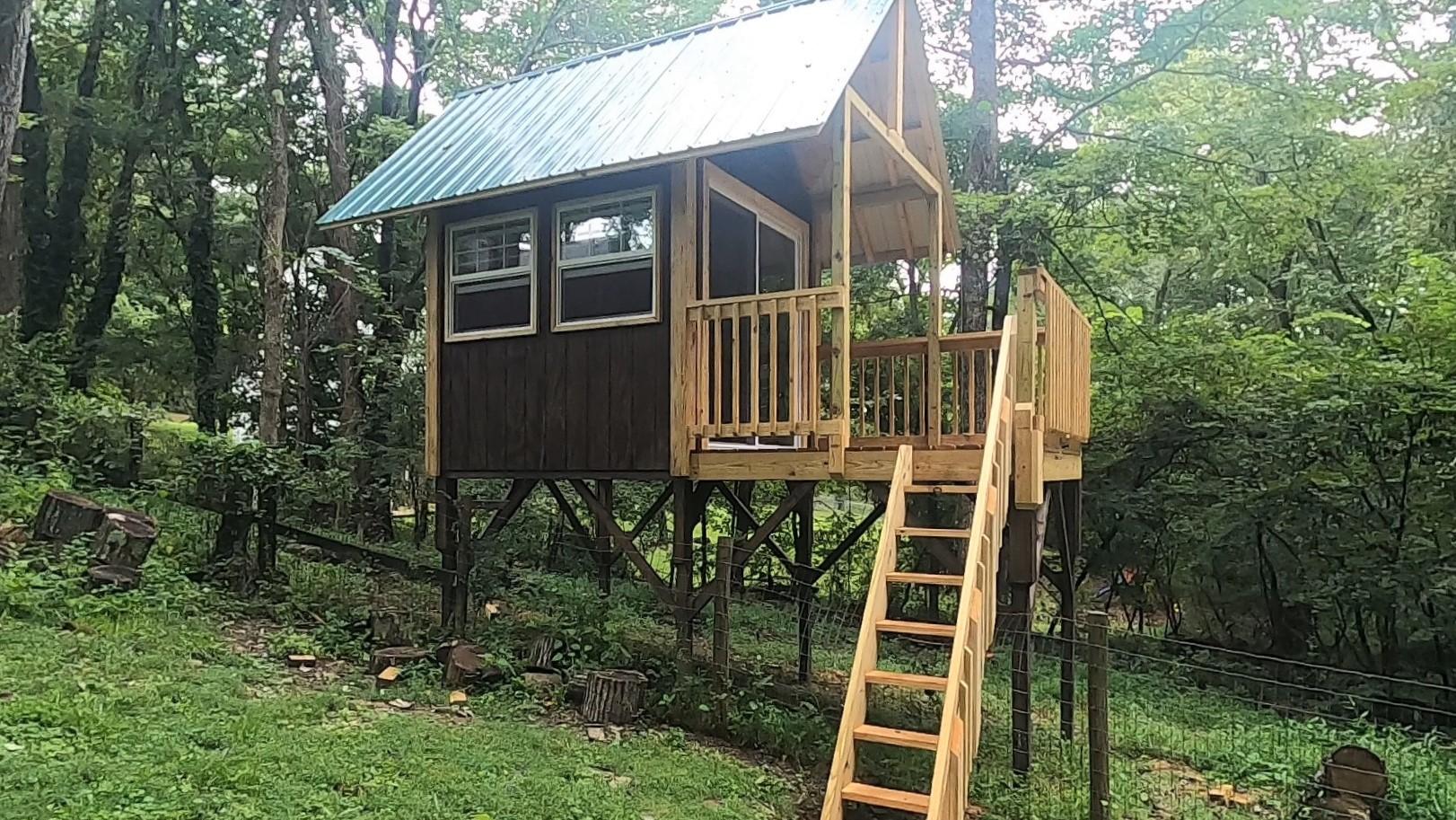.jpg)

I had been planning a treehouse, for the kids, for a while now. I originally wanted a true treehouse in a tree. There was a nice healthy oak tree in the backyard, that would have been perfect, if it hadn't been blown over during a very rainy and windy storm. So instead of a traditional treehouse, I made an elevated house amongst the trees. One feature that does use trees is the zip line that can be used to get up to and down from the porch. I am going to break the project into different sections to show you how I did each part. Hopefully you can learn from my triumphs and mistakes and use this information to help you make your own backyard treehouse.
Supplies


A collection of your average woodworking tools, saw, hammer, drill, impact driver, sander will be needed to build a backyard treehouse. Since this was high off the ground, I used a couple of ladders. I even bought a new tool; a power planner to plan some rough cut lumber to recycle into smooth usable wood. Some wrenches were needed for the cable clamps on the zip line. I used post hole diggers to dig the holes for the support posts and a shovel and wheelbarrow to mix the cement for the posts.
DANGER!
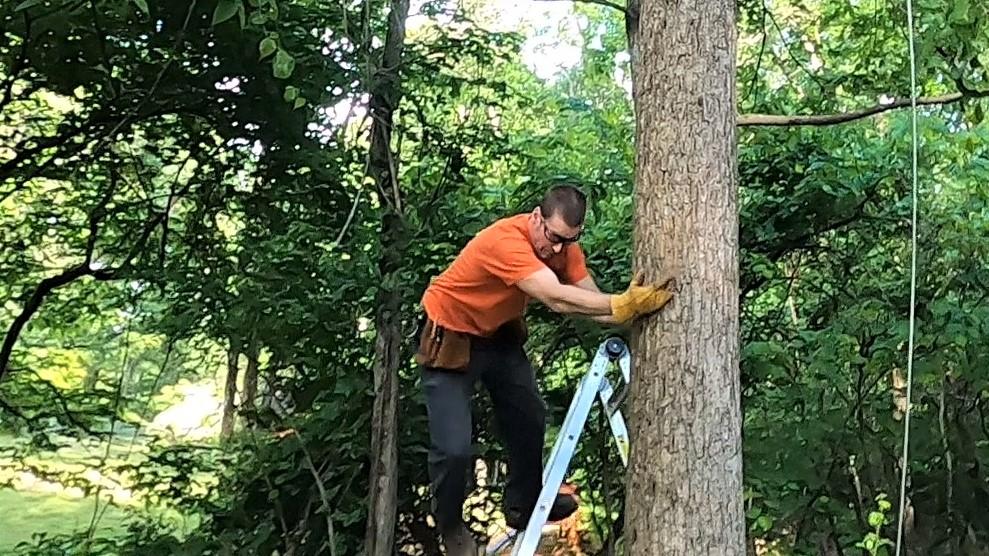.jpg)
As with most of my projects, there is always potential for injury. I fell from a ladder, found a hornets nest, got sunburned, almost got struck by lightning, strained a few muscles, and got dehydrated. Be safe. Wear safety glasses, gloves, hearing protection, sturdy shoes and take your time. This is a big project and will take several days. Plan ahead for potential safety issues and avoid injury.
Zip Line
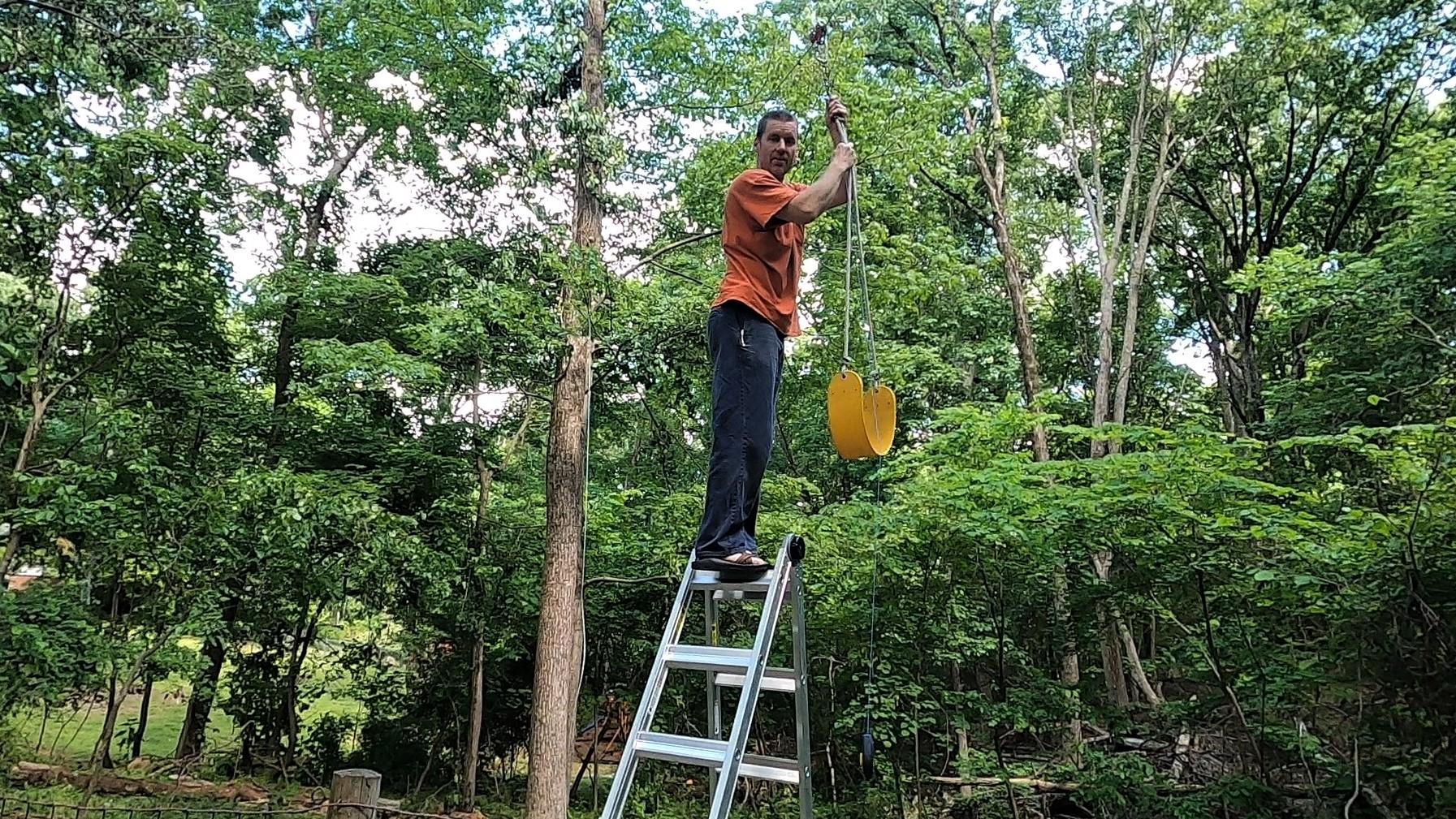.jpg)
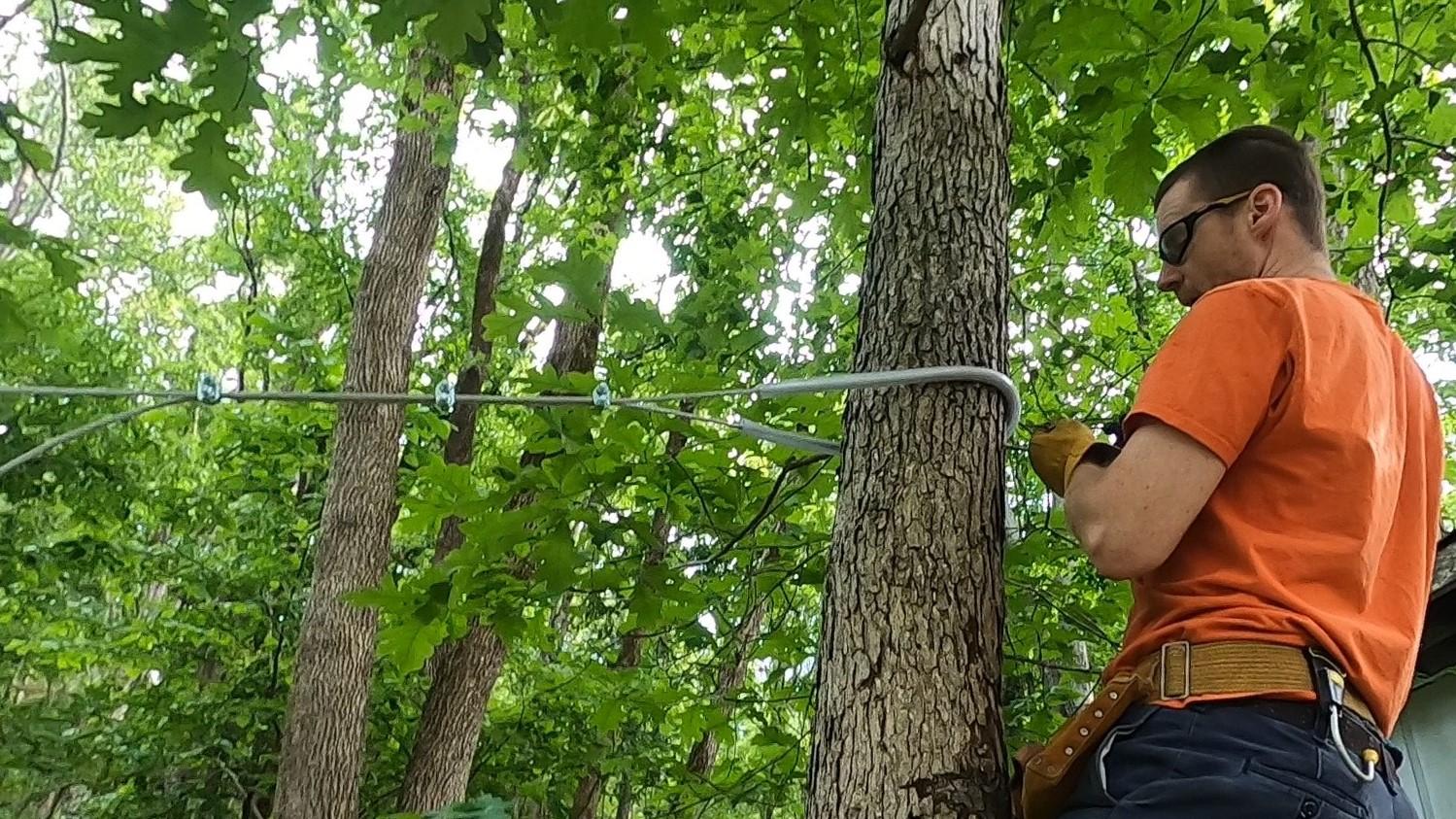.jpg)
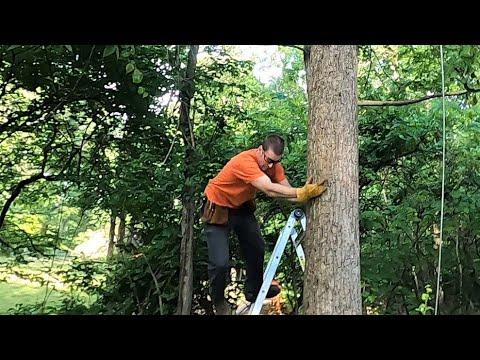)
One of the main features that I wanted to include was a Zip Line. We had a treehouse with a zip line growing up. My sisters and I survived our childhood so I thought that my children could use the experience of fun and danger that a zip line can provide. I picked two sturdy trees and installed a Zip Line.
I have made an Instructable on a Zip Line Swing that can be seen here: https://www.instructables.com/Zip-Line-Swing/
Location, Location, Location




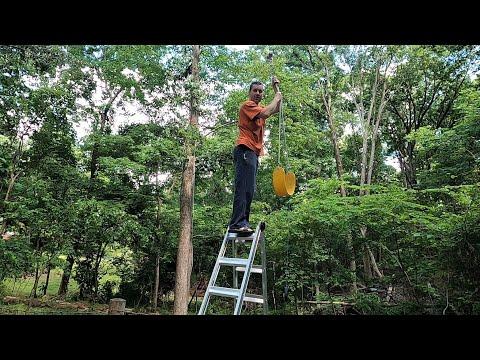)
I wanted the zip line to be in the center of an opening on the deck of the treehouse. Since the trees that the zip line are attached to determined the location of the zip line, I used the zip line to determine the location of the treehouse deck. I used a chalk line as a plumb bob to mark the ground directly under the sip line. I then measured off of this mark to mark where the post holes should be.
Dig Holes

Some people will say a PHD (post hole digger) is too expensive and not useful. Trust me, a post hole digger is not that expensive and I think is the best tool to dig a hole for a post. There are different ideas on how deep a post hole needs to be. I just dug till I hit rock, tried breaking up the rock to dig deeper, and then stopped when the rock layer was too hard to break up.
Plumb Posts




)
I rigged up a series of boards screwed to the posts to hold them in position and plumb so that they would not move while the cement was being poured and set up. These boards would be removed after the cement set up.
Cement Posts








I mixed up the cement and then used a shovel to carefully pour it into the holes around the posts. I waited a few days to give the cement time to fully set up before continuing on with the rest of the treehouse.
Floor Joists











I framed out the floor joists level and cut the support posts even with the top of the floor joists.
Gussets












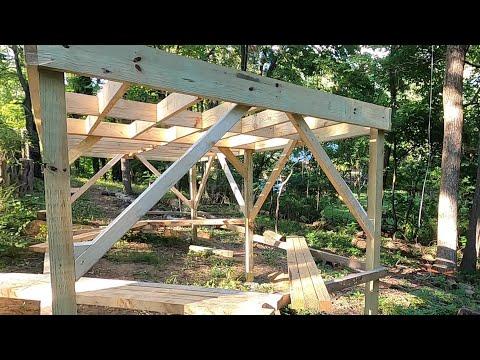)
Once my floor joists were in place, I decided that the structure was a bit wobbly. I used 4x4 posts instead of 6x6 posts because they were not as expensive. The 6x6 posts would have probably not been as wobbly. To fix the wobbly problem, I decided to install gussets. I made the gussets out of 2" x 3" wood that I had reclaimed from runners used to ship goods on. I made a 90 degree corner on one end and a 45 degree cut on the other end. I used a piece of plywood to position one end flush with the top of the floor joists and positioned the other end on the post. I screwed scrap triangle pieces (from the 45 degree cut from the end of the gussets) at the connection to the posts to both reinforce the connection and to prevent an entrapment hazard at that point. I also made a ladder for the hidden trap door on two of the gussets. The gussets solved the wobbly problem and added an artsy look.
Deck Floor and Trap Door
































I used treated decking wood for the deck section of the treehouse floor. I used treated 3/4 plywood glued and screwed to the joists for the inside floor section. I wanted a secret trap door in the back corner of the treehouse. I framed out the trap door section of the frame and temporarily placed the 3/4" plywood to trace the location of the trapdoor frame so I could cutout the trapdoor. I used a jigsaw and made plunge cuts so that the trapdoor grain would match the rest of the grain on the plywood floor. I installed a piano hinge on the trap door. I later installed a door latch that could be used to lock the trap door from the inside and also safely hold the door open by latching it to the wall.
Deck Cutout for Posts





I knew that I would be adding posts for the corners of the deck and for supporting the roof over part of the deck. I cut out the deck boards in these locations, so the posts could rest directly on the floor joists and posts underneath.
Free Wood, Worth It?






I had access to some free wood. It was rough cut so it would need to be planned to be nice looking and splinter free in places that it could be touched. I bought a power planner to smooth down all the boards. It took me two days and four sets of blades on the planner to get all the boards smooth. I used some of these boards rough, in the rafters, where the boards would not be touched and they gave a nice rustic look. I could have just bought boards but I think it was worth the effort to reuse these boards that would have otherwise been in a landfill.
Planning Jig











I found holding the boards steady to plane a chamfer on the corners difficult so I built a crude jig to hold the boards in place. I made an Instructable of this jig here: https://www.instructables.com/45-Degree-Board-Holding-Jig-for-Chamfer-Planning/
Storms!







There were numerous storms over the course of the summer that I built this treehouse. Some things I could plan around like cement in the post holes on a week that was forecast to be dry. Other times I had to prevent water damage by temporarily installing sheets of plastic and tarps.
Framing Walls































After planning all the free wood smooth, I used it to frame out the walls. Three of the walls I framed out to have two windows. I have only installed two windows on one of the walls but having the framing in the other walls would make it easier to install windows in the future. I made the walls laying flat on my concrete driveway. I then laid them flat on the floor of the treehouse and attached the outside plywood sheeting on to the walls. I then raised them into place and held them in place with some temporary boards. I decided that the back wall would be easier to raise into place and add the outside plywood sheeting.
Door Wall















I made the frame for the sliding glass door wall, the same way as the other three walls, laying flat. I used the frame of the sliding glass door to layout the lumber for the wall. This wall was a bit heavy but we were able to get it and the other three wall sections up to the treehouse by using the zip line like a ski lift which was much safer and easier than carrying them up ladders.
Rafters
























I used the same technique with the rafters as I did with the walls. I used the same 2x3 reclaimed boards as the walls but left them rough since they would be high enough that no one would touch them. I laid them out flat on the driveway and fit them on the wall frames. I designed them to have a 2x6 ridge board. I used a small birds mouth cut for where they would sit on top of the side walls. I made center support boards for the ridge board at the front and back wall and also at the roof end support that covers half the deck. I installed those six rafters with the center supports first to help hold the ridge board in place and then installed the rest of the rafters.
Ladder or Stairs? Both?


































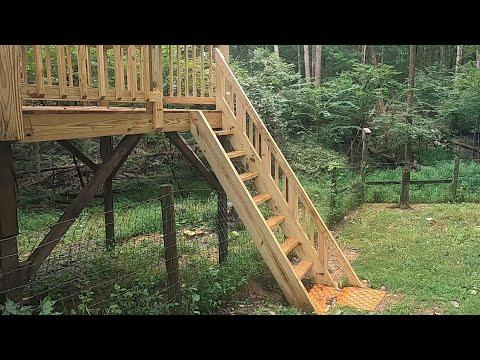
Out of all the elements of this treehouse, the stairs/ladder design haunted me the most. I finally decided that I wanted both. Basically I ended up making really steep stairs with one handrail. I decided the angle of the ladder stairs (35 degrees) by holding a long board, one end on the ground and leaned it up against the deck so that it would just clear the fence in our backyard. I used 2x12 stringers and cut dados in them for the steps which I glued and screwed in. On one side, I cut the stringer flush with the deck. On the other side, I used a birds mouth where the stringer would go up to join in the guardrail post on the deck. I made vertical pieces to hold up a handrail that also connected to the guardrail post on the deck. I dug a trench and lined it with gravel for the bottom step to rest on. These ladder stairs probably violate multiple building codes but the size of my treehouse didn't need a building permit, where I live, and they have been working fine. I just wish I had decided on the design earlier because it would have come in handy to have them in place for the rest of the treehouse construction.
Metal Roof






















Of course when I was building the rafters and installing the metal roof, rain started. I put up a tarp to keep everything dry. In between rain showers, I could roll back the tarp and install sections of roof and then roll the tarp back on as the rain started again. I put some horizontal cross pieces between the rafters to support the metal roofing and give me something to screw the roofing to. I used a pair of small vice grip plyers tied to a cord so that I could pull up the metal roof sections. Once up, I would use the same vice grip plyers to hold the roofing piece to the previous roofing piece. To help keep the screws even and lined up, I used the tape from a broken tape measure, taped magnets to it and hooked it right beside where I would be placing screws. Ticks were crazy this summer and they were crawling to the highest point of the treehouse looking for a host. I finished off the top of the roof with a matching ridge cap.
Staining










I used deck and siding stain to stain the outside sheeting of the treehouse. I put small amounts of the stain in an old plastic container to have something lighter and in case I dropped it, I would not loose all of the stain.
Sliding Door



































)
A sliding door may sound like a bad idea for a treehouse but I think it is better than a regular door. A regular hinged door with a hinged screen door would take up room inside and outside the treehouse. A sliding door doesn't need to swing in and out leaving space inside and out free to use. At first the sliding door seamed too expensive but it cost the same as a door, screen door, and window, which is what I was originally thinking of putting on this wall originally. The instructions that came with the sliding door placed importance on having a good level and square opening so I made sure the opening was perfect before installing the door.
Windows
















I drilled a hole in each corner of the opening for the windows in the outside sheeting. I used a sawsall to cutout the siding. I caulked and screwed the windows into the openings. I then used treated 2x4s ripped to 2x2s to make a frame around the windows.
Hinged Gable Vents




















































I had intentionally designed the roof of the treehouse to have a large overhang on both ends of the treehouse. One end covers half of the deck but the other end overhangs to keep weather out of the gable vents. I originally thought that I would just have a screened opening at each of the gables. I thought of a way to be able to allow more or less air to pass thru the gable vents by having hinged doors over the screened openings.
I started by cutting triangle shaped pieces of exterior siding to cover the gables. I temporarily screwed the pieces in place. I then traced where the frame pieces of the gables were on the triangle pieces. I used these lines as guides to mark the cutouts for the doors 3/4" larger than the triangle opening in the gable frames. This would make it so the triangle gable doors would use the gable frames as a door stop.
When cutting out the gable doors, I started by cutting the hinge side first. I then installed the hinges and then gut out the rest of the doors.
I used a trick to make the hinge screw holes line up with the hinge holes. I used a drill the same size as the holes in the hinges to match drill a shallow hole in the siding. This shallow hole would act as a center punch to guide the proper size drill for the hinge screws.
Before putting up the finished gable vent doors, I stapled some screen material to the gable frames.
After installing the gable vent doors, I used screw eyes to fasten a cord to the corners of the gable vent doors. I passed these cords thru some other screw eyes that I used like a pulley to be able to open and close the gable vent doors. I screwed some screws part way into the posts to use as cleats to wrap the cords around to hold the gable vent doors in place. I can open up the vent doors in hot weather or close them for cold weather.
Rails

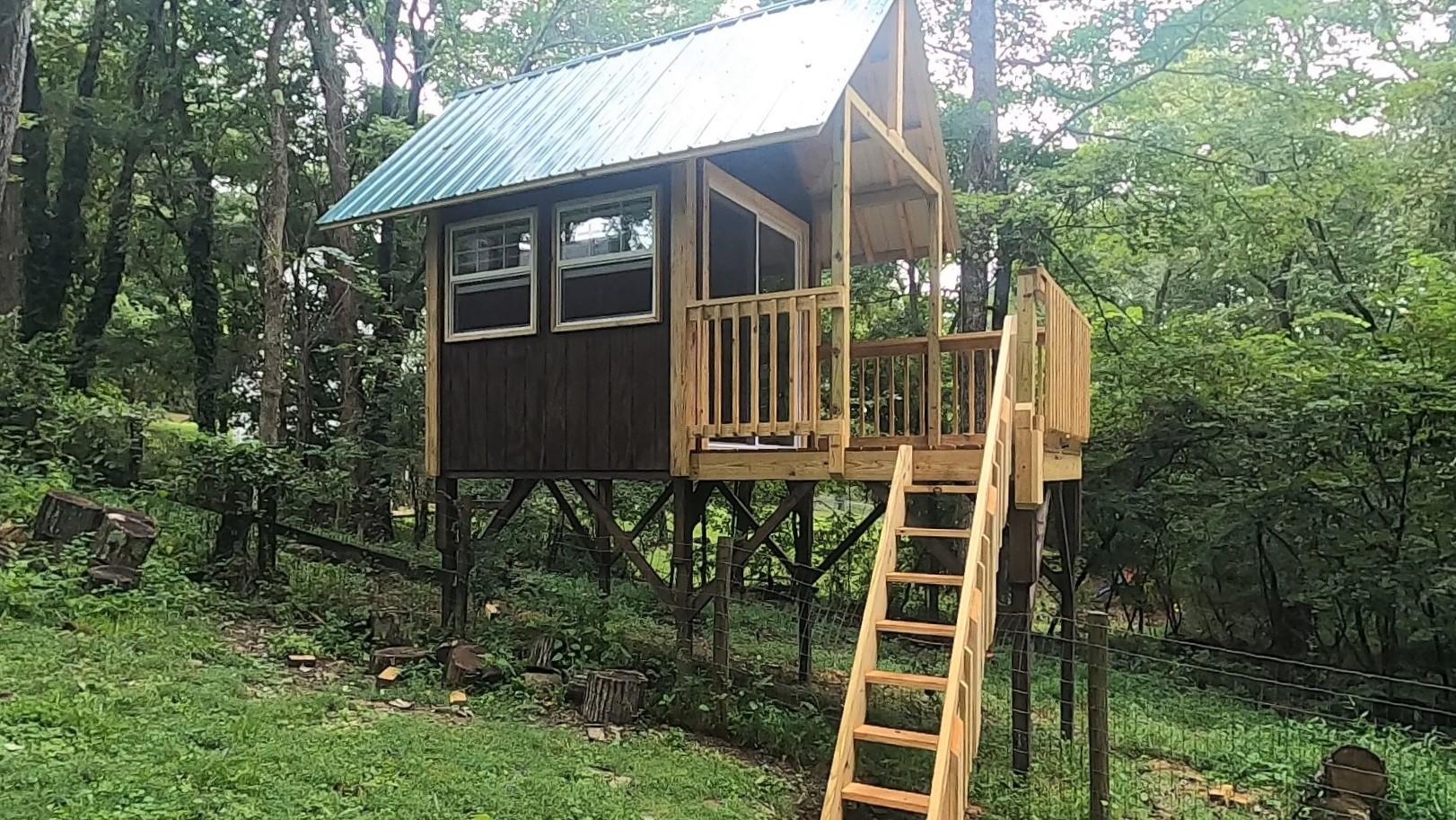.jpg)

I used treated wood to make rails around the deck of the treehouse. I used local code to make sure the railing would be safe. Spacing between the vertical pieces is important to keep from having an entrapment hazard.
Hammocks



I used some purpose built brackets to hang two hammocks from opposite diagonal corners of the wall frames.
Conclusion
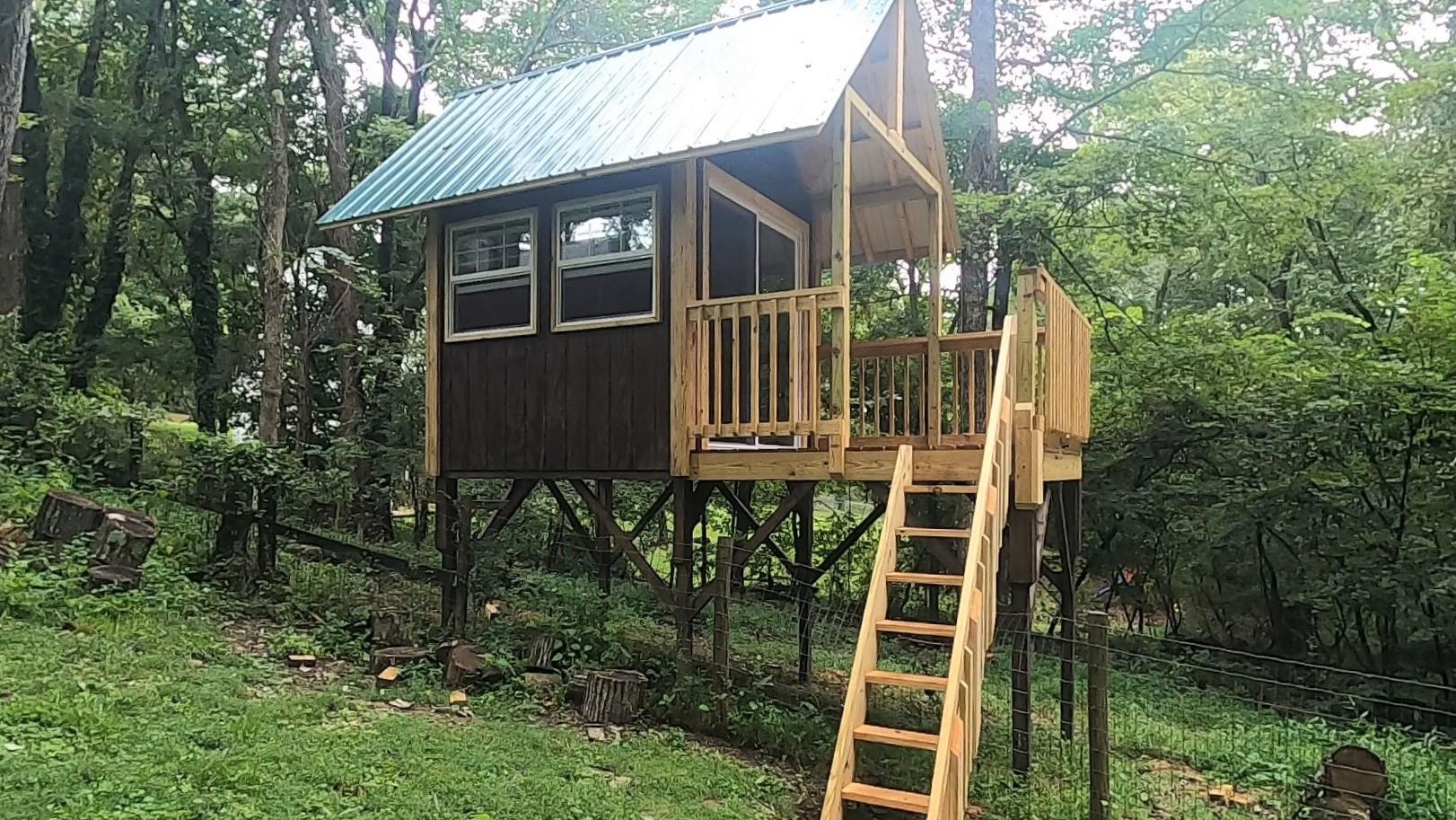.jpg)
I built this treehouse during the Summer of 2020. It was a long project that kept the whole family busy and entertained during a time where the whole world seamed to be at a standstill. There are a few things I would do differently, if I were going to do it again, but for the most part, the treehouse has worked perfectly. The kids love playing in it and we have even had "camp outs" overnight in the treehouse. When the kids grow out of it, the treehouse could be converted into an office or spare room. I hope this will give you some ideas to use on your own treehouse. Thank you for viewing my Instructable.